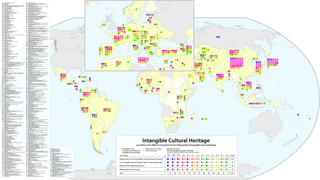
A World Heritage Site is a landmark or area with legal protection by an international convention administered by the UNESCO. World Heritage Sites are designated by UNESCO for having cultural, historical, scientific or other forms of significance. The sites are judged to contain "cultural and natural heritage around the world considered to be of outstanding value to humanity".
The Proclamation of Masterpieces of the Oral and Intangible Heritage of Humanity was made by the Director-General of UNESCO starting in 2001 to raise awareness of intangible cultural heritage and encourage local communities to protect them and the local people who sustain these forms of cultural expressions. Several manifestations of intangible heritage around the world were awarded the title of Masterpieces to recognize the value of the non-material component of culture, as well as entail the commitment of states to promote and safeguard the Masterpieces. Further proclamations occurred biennially. In 2008, the 90 previously proclaimed Masterpieces were incorporated into the new Representative List of the Intangible Cultural Heritage of Humanity as its first entries.
An intangible cultural heritage (ICH) is a practice, representation, expression, knowledge, or skill considered by UNESCO to be part of a place's cultural heritage. Buildings, historic places, monuments, and artifacts are cultural property. Intangible heritage consists of nonphysical intellectual wealth, such as folklore, customs, beliefs, traditions, knowledge, and language. Intangible cultural heritage is considered by member states of UNESCO in relation to the tangible World Heritage focusing on intangible aspects of culture. In 2001, UNESCO made a survey among states and NGOs to try to agree on a definition, and the Convention for the Safeguarding of the Intangible Cultural Heritage was drafted in 2003 for its protection and promotion.

Keşkek, also known as kashkak, kashkek, or keške, is a ceremonial meat or chicken and wheat or barley stew found in Turkish, Iranian, Greek, Armenian and Balkan cuisines.

The Citadel, also known as the Castello, is the citadel of Victoria on the island of Gozo, Malta. The area has been inhabited since the Bronze Age, and the site now occupied by the Cittadella is believed to have been the acropolis of the Punic-Roman city of Gaulos or Glauconis Civitas.

Soup joumou is a soup native to Haitian cuisine. In 2021, soup joumou was added to the UNESCO Intangible Cultural Heritage List.

The World Heritage Convention, formally the Convention Concerning the Protection of the World Cultural and Natural Heritage, is an international treaty signed on 23 November 1972, which created the World Heritage Sites, with the primary goals of nature conservation and the preservation of cultural properties. The convention, a signed document of international agreement, guides the work of the World Heritage Committee. It was developed over a seven-year period (1965–1972).

UNESCO established its Lists of Intangible Cultural Heritage with the aim of ensuring better protection of important intangible cultural heritages worldwide and the awareness of their significance. This list is published by the Intergovernmental Committee for the Safeguarding of Intangible Cultural Heritage, the members of which are elected by State Parties meeting in a General Assembly. Through a compendium of the different oral and intangible treasures of humankind worldwide, the programme aims to draw attention to the importance of safeguarding intangible heritage, which UNESCO has identified as an essential component and as a repository of cultural diversity and of creative expression.

Ojkanje is a tradition of polyphonic folk singing in Croatia characteristic for the regions of the Dalmatian hinterland, Velebit, Lika, Kordun, and Karlovac. As described in The Harvard Dictionary of Music: "The ojkanje is a particular style of singing melisma with a sharp and prolonged shaking of the voice on the syllables oj or hoj." According to experts, ojkanje is a remnant of pre-Slavic Illyrian singing from the area of ancient Dalmatia.

The Convention for the Safeguarding of the Intangible Cultural Heritage is a UNESCO treaty adopted by the UNESCO General Conference on 17 October 2003.
Intangible cultural heritage (ICH) includes traditions and living expressions that are passed down from generation to generation within a particular community.









